Nevada << nuh VAD uh or nuh VAH duh >> is a state in the western United States. It is a popular center of tourism. Nevada was the first state to allow widespread casino gambling. Large, luxurious gambling casinos attract visitors from all parts of the world to Lake Tahoe, Las Vegas, and Reno. Las Vegas is the largest city in Nevada, the state’s chief tourist attraction, and one of the leading tourist destinations in the world.
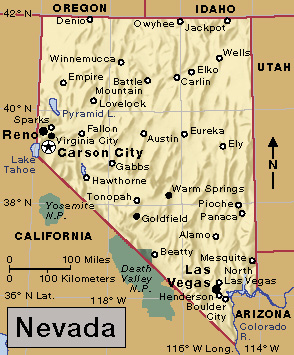
Nevada is a land of rugged snow-capped mountains, grassy valleys, and sandy deserts. Pine forests cover many mountain slopes, and crystal-clear streams flow through steep, rocky canyons. Large trout swim in sparkling valley lakes. In many places, geysers erupt and hot springs gush amid the rocks. In the south, bighorn sheep graze on jagged plateaus that glow red in the brilliant sunshine. Glistening white patches called alkali flats stretch across the deserts. The flowers of cactus, yucca, and sagebrush plants add splashes of color. The gray-green sagebrush gave Nevada one of its nicknames, the Sagebrush State.
The state’s most common nickname, the Silver State, comes from the vast amounts of silver that were once taken from its many mines. Colorful ghost towns and historic mining towns, such as Virginia City, now attract thousands of tourists to the state every year. But mining is still one of the chief industries of Nevada. The most important minerals in the state include diatomite, gold, petroleum, sand and gravel, and silver. These resources support the state’s manufacturing and processing industry.

Mining remains important to Nevada’s economy. Nevada ranks as one of the leading states in mining income. The state’s most important mined product is gold, and Nevada leads the country in gold production. Other important mined products include copper, lime, sand and gravel, and silver.
Less rain falls in Nevada than in any other state. As a result, farming depends on irrigation. The Newlands Irrigation Project, near Reno, was the first system of its kind built by the federal government. Hoover Dam, on the Colorado River, created Lake Mead, one of the largest artificially created lakes in the world. The dam’s power plant supplies electric power for Arizona, California, and Nevada.
Nevada is one of the most urbanized states in the nation. More than 90 percent of the state’s people live in cities and towns. The vast majority of the population lives in the Las Vegas and Reno areas. The state has limited areas suitable for farming and ranching. Farming is less important in Nevada than it is in most other states.
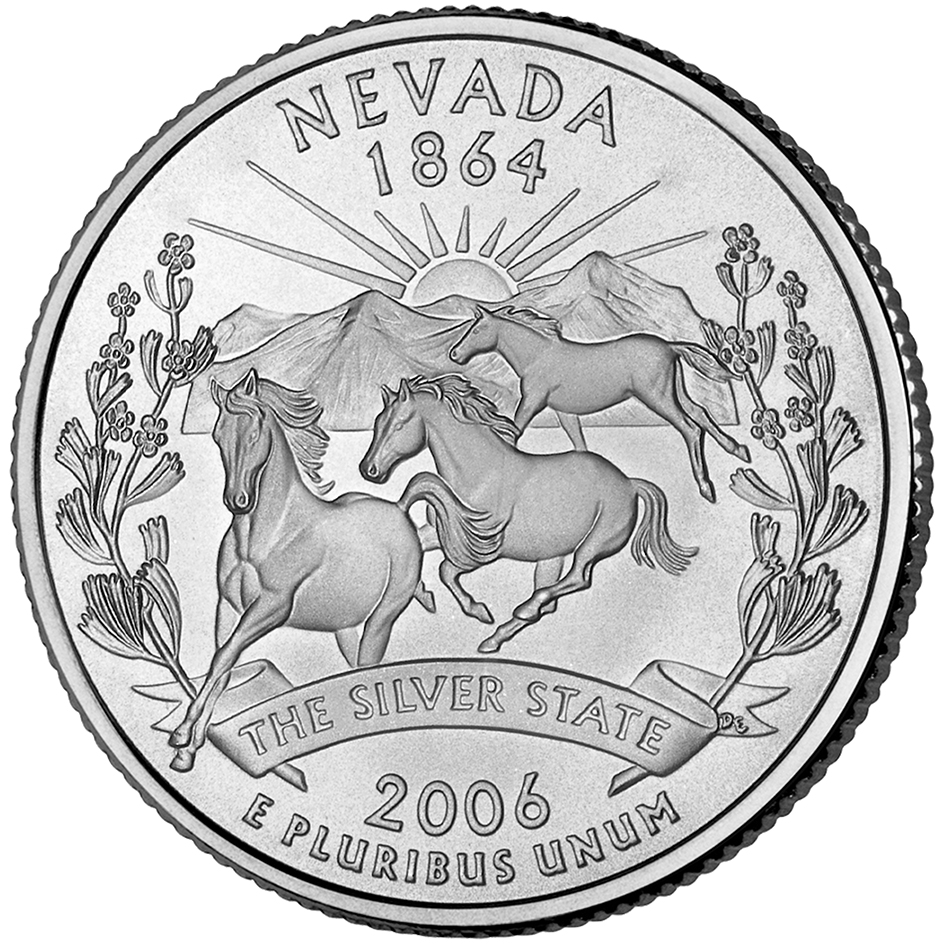
Nevada lies mainly on a broad, rugged highland between the Rocky Mountains and the Sierra Nevada mountain range. In the 1820’s and 1830’s, the trappers Peter S. Ogden, Jedediah S. Smith, and Joseph Walker explored parts of the region in search of new fur sources. John C. Frémont began the first thorough exploration in 1843. By the 1860’s, discoveries of gold and silver had brought thousands of miners to the area.
The name Nevada comes from a Spanish word meaning snow-clad. Miners and other settlers chose the name Nevada when the region became a territory in 1861. Nevada became a state in 1864 during the American Civil War and was nicknamed the Battle Born State.
People
Population.
The 2020 United States census reported that Nevada had 3,104,614 people. The population had increased 15 percent over the 2010 figure, 2,700,551. According to the 2020 census, Nevada ranks 32nd in population among the 50 states.
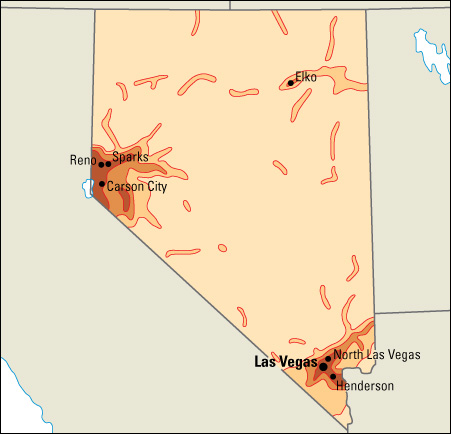
About 90 percent of Nevada’s people live in three metropolitan areas (see Metropolitan area). The metropolitan areas are Carson City, Las Vegas-Henderson-North Las Vegas, and Reno. Over 70 percent of Nevada’s population lives in the Las Vegas-Henderson-North Las Vegas metropolitan area. The Reno metropolitan area contains over 15 percent of the population. Las Vegas is Nevada’s largest city, and Henderson is the second largest city in the state.
Besides Las Vegas and Henderson, only eight of Nevada’s urban areas have populations greater than 50,000. These areas are Enterprise, North Las Vegas, Paradise, Spring Valley, and Sunrise Manor, all near Las Vegas; Reno; Sparks; and Carson City, the state capital.
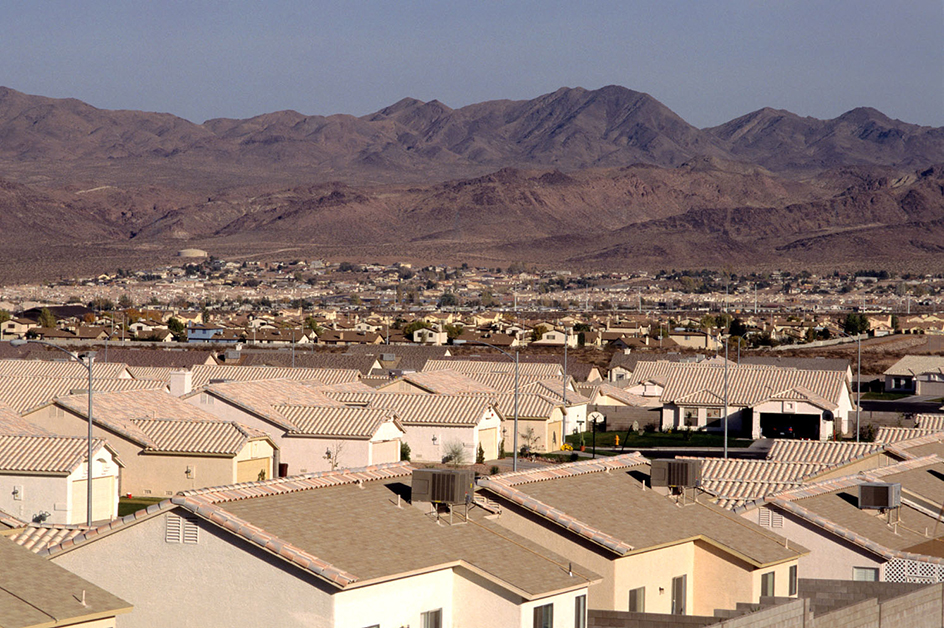
Hispanics account for about 30 percent of Nevada’s population. African Americans make up 10 percent.
People in the Las Vegas area have long depended on the tourism and gambling industries for employment. Since the 1980’s, however, retirees and other newcomers to the area have helped create jobs in such fields as health care and real estate. Reno, another tourist favorite, is the center of banking, commerce, and transportation in northern Nevada. 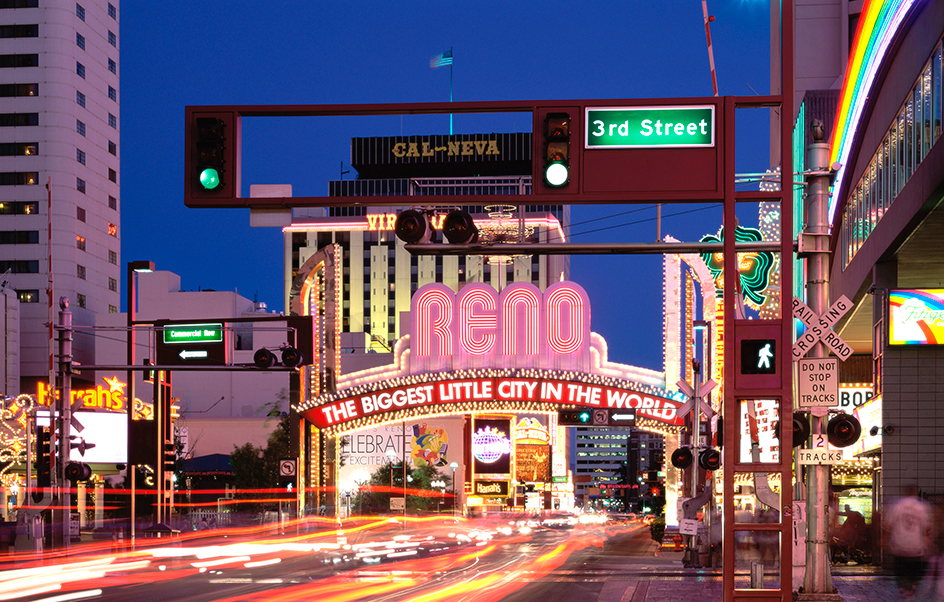
Schools.
The people of Nevada made plans for a tax-supported school system as early as 1861, when Nevada became a territory. In 1865, the year after Nevada became a state, the Legislature established the first school districts. Nevada had to overcome unusual problems in developing its public school system. Rural areas were thinly populated. In some places, taxpayers supported schools for as few as three or four school-age children living in a vast area. Some early schools were open only six months of the year because of a lack of funds. Until 1900, the state had only a few high schools. In some parts of Nevada, elementary school students still attend one-room schools. 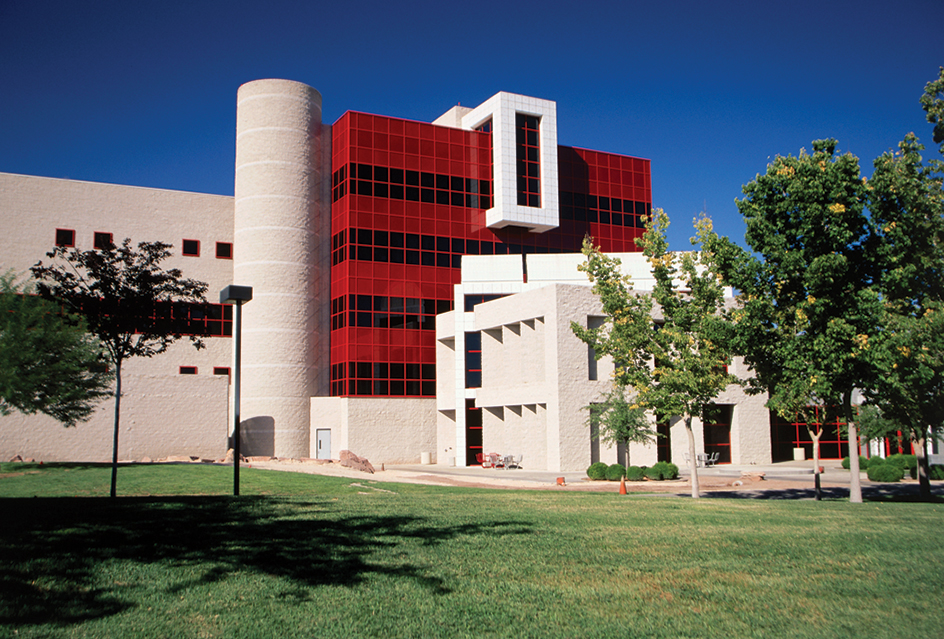
A state Department of Education supervises Nevada’s schools. The department includes the State Board of Education and the superintendent of public instruction. The board has 10 voting members and 1 nonvoting student representative. Four members are elected, and the rest are appointed by various government bodies and educational associations. The governor appoints the superintendent of public instruction, who heads the Department of Education.
Each Nevada county makes up a school district. Each district has its own elected Board of Trustees. Children must attend school between the ages of 7 and 18. For the number of students and teachers in Nevada, see Education (table: U.S. students, teachers, and school expenditures).
Libraries.
The University of Nevada has two of the largest libraries in the state on its campuses in Las Vegas and Reno. The Nevada State Library and Archives in Carson City serves as the official library for the state government and also as the reference and research center for other libraries throughout the state. Nevada has public libraries throughout the state.
Museums.
The Nevada Historical Society in Reno and the Nevada State Museum in Las Vegas have exhibits on the region’s history. The Nevada State Museum in Carson City houses such exhibits as an underground mine, a ghost town, a reconstructed mammoth, and a historic coin press.
The Lost City Museum in Overton has many items found at the Pueblo Grande de Nevada, an ancient Native American settlement. Lake Mead now covers part of the site of the ancient city.
The Old Las Vegas Mormon Fort State Historic Park includes part of a fort built by Mormon pioneers. The University of Nevada, Las Vegas, operates the Marjorie Barrick Museum of Art, devoted to the cultures of the American Southwest. The Northeastern Nevada Museum in Elko includes an extensive history gallery, photography exhibits, and historical reproductions of a ranch kitchen, a general store, and a printing shop. The National Automobile Museum in Reno features a collection of antique, classic, vintage, and special interest vehicles.
The Nevada Museum of Art in Reno houses a collection based on the theme of land and the environment. The W. M. Keck Earth Science and Mineral Engineering Museum at the University of Nevada in Reno focuses on mining and the history of mining.
Visitor’s guide
Gambling and the colorful night life in Las Vegas and Reno draw millions of tourists every year. Virginia City and other historic Nevada towns remind travelers of the prospectors who came west seeking fortunes in gold and silver. Sports enthusiasts hunt mule deer and chukar partridge, and fish for catfish, bass, salmon, and trout. Skiers race down the snow-covered slopes of the Lake Tahoe basin and the Sierra Nevada near Reno, and Mount Charleston near Las Vegas. Vacationers also enjoy swimming and water skiing at Lake Mead, Lake Tahoe, and Pyramid Lake.
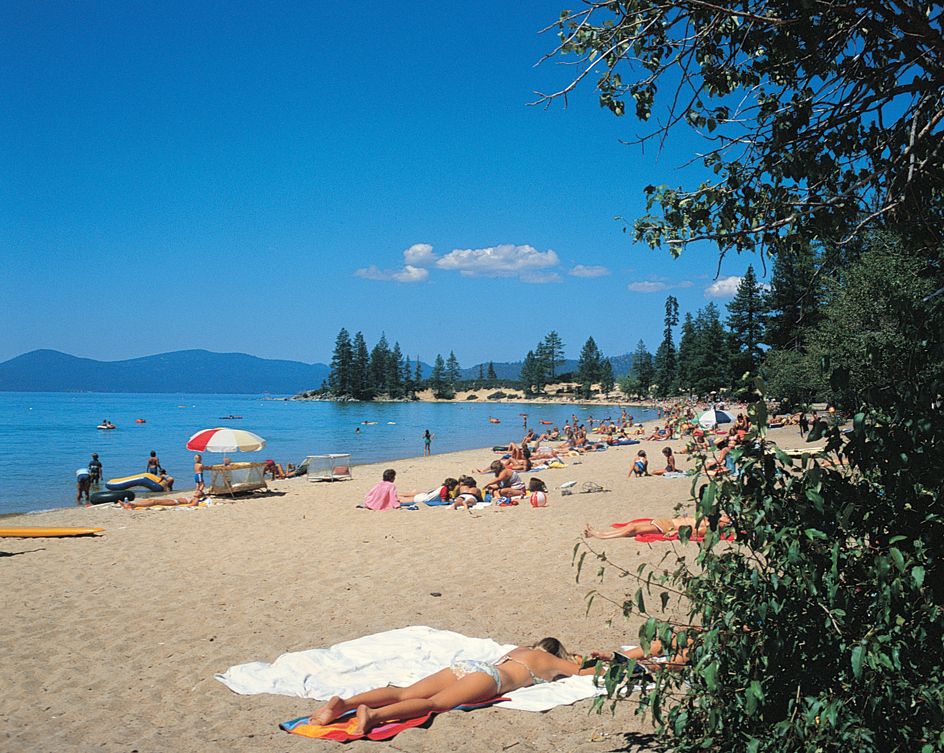
Thousands of classic and vintage automobiles arrive in Reno the first week of August for Hot August Nights, one of Nevada’s largest annual events. Visitors can admire the cars as they are paraded and displayed at numerous shows and events.
Land and climate
Land regions.
Nevada lies almost entirely within the Great Basin, a huge desert area that extends into Oregon, Idaho, Wyoming, California, and Utah (see Great Basin). The state has three main land regions: (1) the Columbia Plateau, (2) the Sierra Nevada, and (3) the Basin and Range Region.
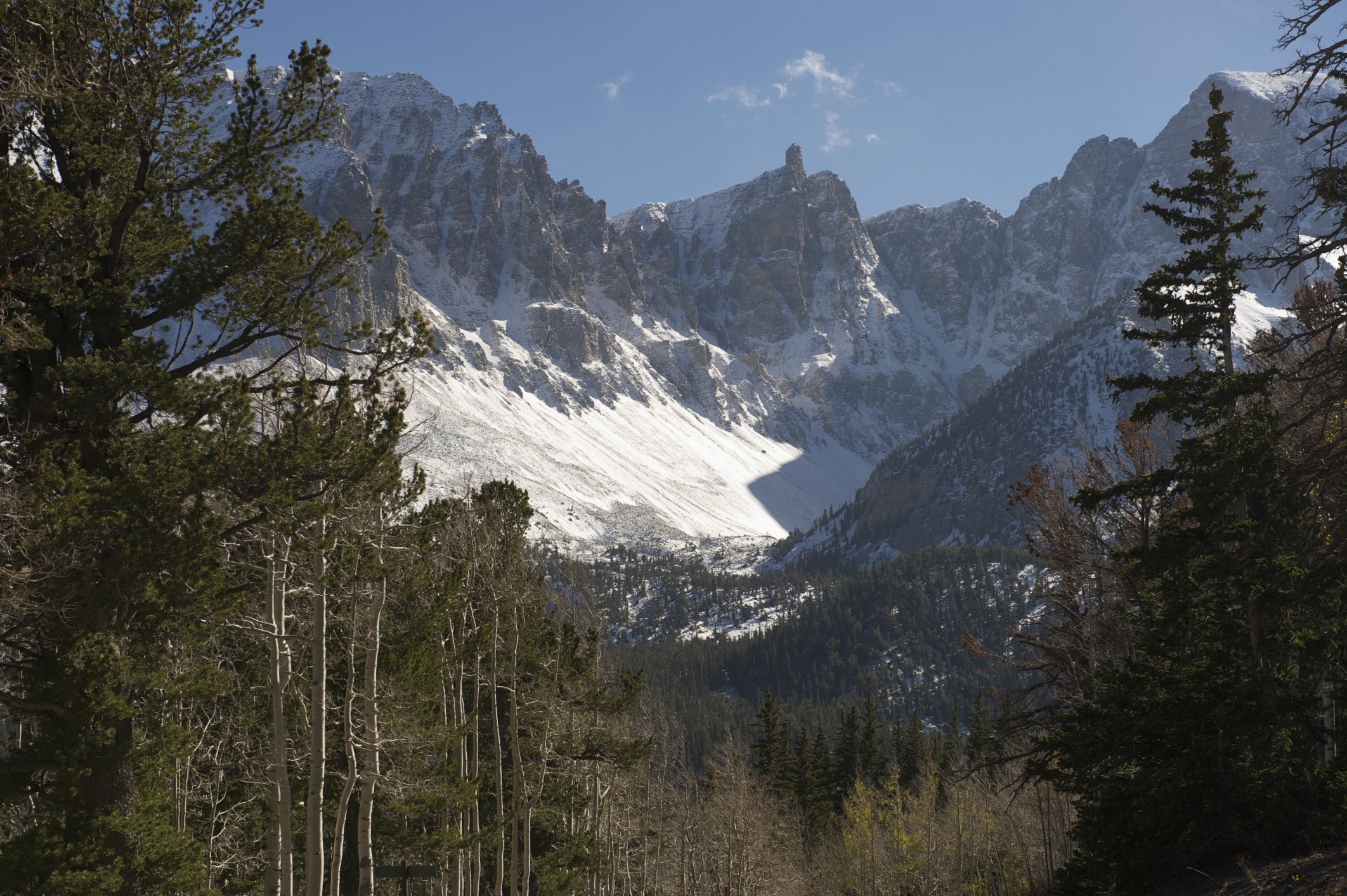
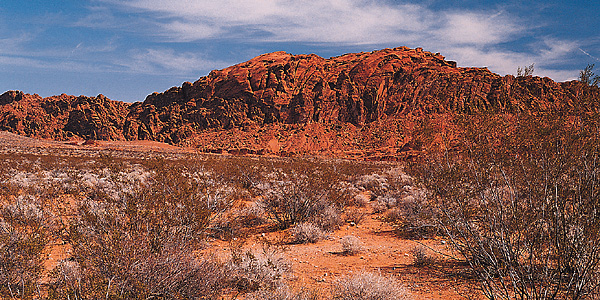

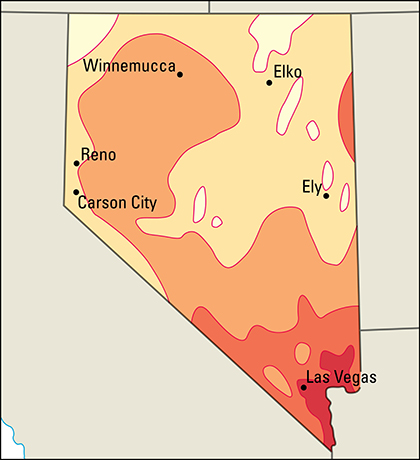
The Columbia Plateau
covers a small part of the northeastern corner of Nevada. Deep lava bedrock lies under the entire region. Streams and rivers have cut deep canyons, leaving steep ridges. The land flattens into open prairies near the Idaho border.
The Sierra Nevada,
a rugged mountain range, cuts across a corner of the state west and south of Carson City. Lake Tahoe and other mountain lakes in this part of Nevada attract many vacationers each year. See Sierra Nevada.
The Basin and Range Region
covers the remainder of the state. It consists mainly of an upland area broken by more than 150 north-south mountain ranges. The towering Sierra Nevada marks part of the western edge of the region. The Toiyabe and Toquima ranges rise in the center of the state. In the east are the Snake and Toana ranges. Between the mountains lie buttes (lone hills) and mesas (tablelike mountains), as well as flat valleys with lakes or alkali flats (see Butte; Mesa).
The elevation of the Basin and Range Region varies from less than 500 feet (150 meters) above sea level near the Colorado River to more than 13,000 feet (3,960 meters) in the southwest. Boundary Peak, the highest point in Nevada, rises 13,140 feet (4,005 meters) in Esmeralda County near the California border. Hot springs and geysers in many places show that Nevada is an area of dying volcanoes.
The southeastern tip of the Basin and Range Region is not part of the Great Basin. But the land here closely resembles that of the Great Basin.
Rivers and lakes.
Most of Nevada’s rivers are small and flow only during the wet season, from December to June. Only a few of the state’s rivers have outlets to the sea. The Virgin and Muddy rivers join the Colorado in the southeastern tip of Nevada. The Owyhee << oh WY hee or oh WY ee >>, Bruneau, and Salmon rivers flow northward across the Columbia Plateau to Idaho’s Snake River.
All of Nevada’s other rivers empty into the Great Basin. They flow into lakes without outlets or into wide, shallow sinks (low spots in the earth). In summer, the water evaporates from the sinks and leaves salty mud flats and dry lakes. The snow-fed Humboldt River is the state’s longest river. It flows westward from the mountains of Elko County for about 300 miles (480 kilometers) and empties into Humboldt Sink. The Carson River winds northeastward from California and empties into Carson Sink. The Walker River also rises in California and empties into Walker Lake. The scenic Truckee River flows northeastward from Lake Tahoe and empties into Pyramid Lake.
Lake Tahoe, on the Nevada-California border, is one of the nation’s loveliest lakes. Lamoille, Liberty, and other beautiful lakes lie among the peaks of the Ruby Range in Elko County. Ruby and Franklin lakes are at the eastern foot of the Ruby Range. Pyramid Lake and Walker Lake are the remains of Lake Lahontan, an ancient lake that gradually dried up. Thousands of years ago, Lake Lahontan covered about a tenth of the present state of Nevada.
Lake Mead, an artificially created lake, is the only Nevada lake with an outlet to the sea. Engineers formed this vast reservoir by building Hoover Dam across a canyon of the Colorado River. See Lake Mead.
Plant and animal life.
Broad stretches of forests cover Nevada’s mountainsides. Common trees include alders, aspens, cottonwoods, firs, hemlocks, junipers, pines, spruces, and willows.
Nevada’s deserts are dotted with cactus, yucca, and a variety of low brush plants. The most common desert plants include the bitter brush, mesquite, rabbit brush, sagebrush, and shadscale. Grasses grow in mountain and valley meadows. Nevada’s meadows bloom in spring with Indian paintbrushes, larkspurs, shooting stars, and violets. In early spring, blood-red blossoms of the snow plant push through the snow in the pine forests. Wild peach blossoms and desert lilies brighten Nevada’s foothills in spring and summer.
Nevada has few large animals, but hundreds of small animals live in the state. Mule deer roam the mountain forests. Pronghorns live mainly in the Charles Sheldon Antelope Refuge in Washoe County (see Pronghorn). Bighorn sheep climb the steep, rocky slopes of the Sheep Range in Clark County. Nevada also has herds of wild horses. Nevada’s small animals include badgers, coyotes, foxes, marmots, minks, muskrats, porcupines, rabbits, and raccoons. Several kinds of lizards and snakes live in the desert. Game birds include chukar partridges, ducks, geese, pheasants, quail, and sage hens. White pelicans, cormorants, gulls, and herons nest in the Anaho Island Refuge in Pyramid Lake. Several kinds of trout make the state a favorite fishing spot. The cui-ui is a large sucker found only in Pyramid Lake. It was once an important food fish among the local Native Americans. Other fishes that swim in Nevada waters include bass, carp, catfish, and crappies.
Climate.
Nevada has less precipitation (rain, melted snow, and other forms of moisture) than any other state. An average of only 8 inches (20 centimeters) of precipitation falls in Nevada annually. The driest regions of the state include the southeastern tip and the land near Carson Sink. 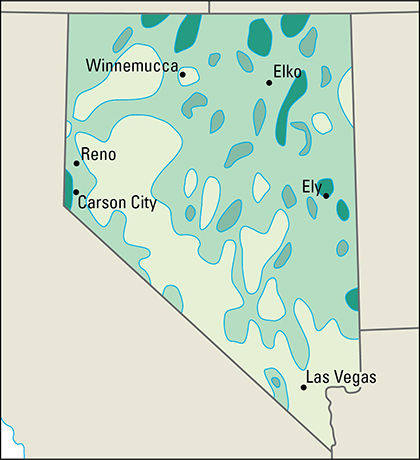
The rainiest parts of Nevada are in the Sierra Nevada and the eastern foothills of these mountains. As much as 25 inches (64 centimeters) of rain falls annually in the Lake Tahoe region of the Sierras. Most of the rain falls during winter. Clouds moving eastward from the Pacific Ocean bring the rain. But the clouds lose most of their moisture in California as they rise over the high Sierra Nevada. Snowfall varies from about 300 inches (750 centimeters) a year in the highest sections of the Sierras to about 1 inch (2.5 centimeters) a year in the southeastern part of the state.
Nevada has a wide range of temperatures. The north and the mountains in all sections have cold, long winters and short, hot summers. The west has short, hot summers, but winters there are only mildly cold. In southern Nevada, summers are long and hot, and winters are mild.
July temperatures average about 70 °F (21 °C) in the north and in the mountains, and 90 °F (32 °C) in the extreme south. January temperatures average 26 °F (–3 °C) in the north and 47 °F (8 °C) in the south. The temperature often changes greatly during the day. In Reno, for example, the temperature may change more than 45 degrees Fahrenheit (25 degrees Celsius) on a summer day. The highest temperature ever recorded in Nevada was 125 °F (52 °C) at Laughlin on June 29, 1994; at Echo Bay on Aug. 6, 1981; and at Echo Bay and Laughlin on Aug. 8, 1985. The temperature reached a record low of –50 °F (–46 °C) at San Jacinto on Jan. 8, 1937.
Economy
Service industries employ a large majority of Nevada’s fast-growing work force. Heavy tourist spending benefits such service establishments as casino hotels, restaurants, and ski resorts. Agriculture and manufacturing are less dominant in Nevada than they are in most other states. Gold is Nevada’s most important mined product.
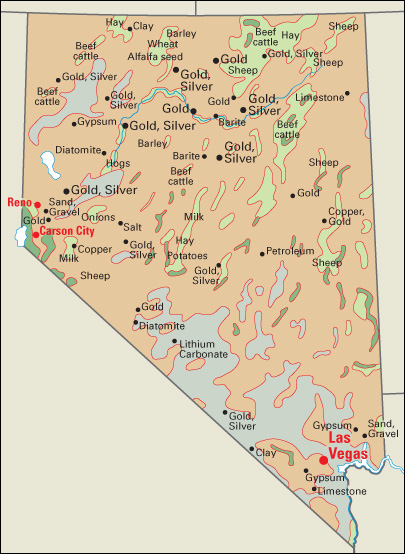
Natural resources.
Nevada’s chief natural resources are its vast mineral deposits, wildlife, and beautiful scenery. In some areas of Nevada, poor soil and lack of water make it difficult or impossible to raise field crops. Thick grasses in some valleys provide grazing for cattle.
Soil.
Most of Nevada is covered with a grayish-brown soil. Many areas have sparse coverings of grasses and brush. With irrigation, Nevada’s soil can grow grain, hay, and other crops. In some valleys, thick layers of sodium carbonate form gleaming white alkali flats, where nothing grows. These flats are sometimes called playas or dry lakes because they may be covered with water after a storm. Much of southern Nevada is covered by light gray soil high in lime or gypsum. Much of the northern section has dark soil formed from volcanic rock.
Water.
Nevada has a limited water supply because of its light rainfall. Water must be carefully conserved when used for personal needs and irrigation. Despite agriculture’s limited impact on Nevada’s economy, farming and ranching activities consume much of the state’s water. Farmers and ranchers pump underground water for their crops and livestock in the Carson, Diamond, Fish Lake, Mason, Smith, Spring, and White River valleys. The largest irrigation systems operate along the rivers. The Newlands Project includes the Lahontan Reservoir, which stores water from the Carson and Truckee rivers. It provides irrigation water for west-central Nevada. Other large irrigation projects include Rye Patch Dam on the Humboldt River, Topaz Reservoir on the Walker River, and Wild Horse Dam in the Owyhee River Valley. The Robert B. Griffith Water Project provides Lake Mead water to the Las Vegas area.
Minerals.
Huge deposits of copper lie in Lander, Lyon, and White Pine counties. Central and northwestern Nevada have large tungsten deposits. Gold and silver have been found in many areas. Other mined resources include barite, clays, diatomite, gemstones, lithium, magnesite, perlite, and salt. Nevada also has valuable deposits of gypsum, limestone, and sand and gravel. Petroleum has been found in some eastern areas of the state.
Service industries
account for over 80 percent of both Nevada’s employment and its gross domestic product—the total value of goods and services produced in the state in a year. These industries are more important to Nevada’s economy than they are to the economies of many other states. Most of Nevada’s service industries are concentrated in the Las Vegas-Paradise and Reno-Sparks metropolitan areas.
Every year, tens of millions of visitors enjoy Nevada’s night life, lovely scenery, and recreational activities. Nevada is one of the leading states in attracting visitors from other countries. Tourist activities contribute billions of dollars to the state annually. Although gambling is legal throughout the state, the vast majority of Nevada’s large casinos are in Las Vegas, Reno, and the Lake Tahoe area. Well-known entertainers from the United States and Europe appear in floor shows at casinos and nightclubs. Dude ranches, fishing resorts, and hunting lodges operate in many areas of the state. 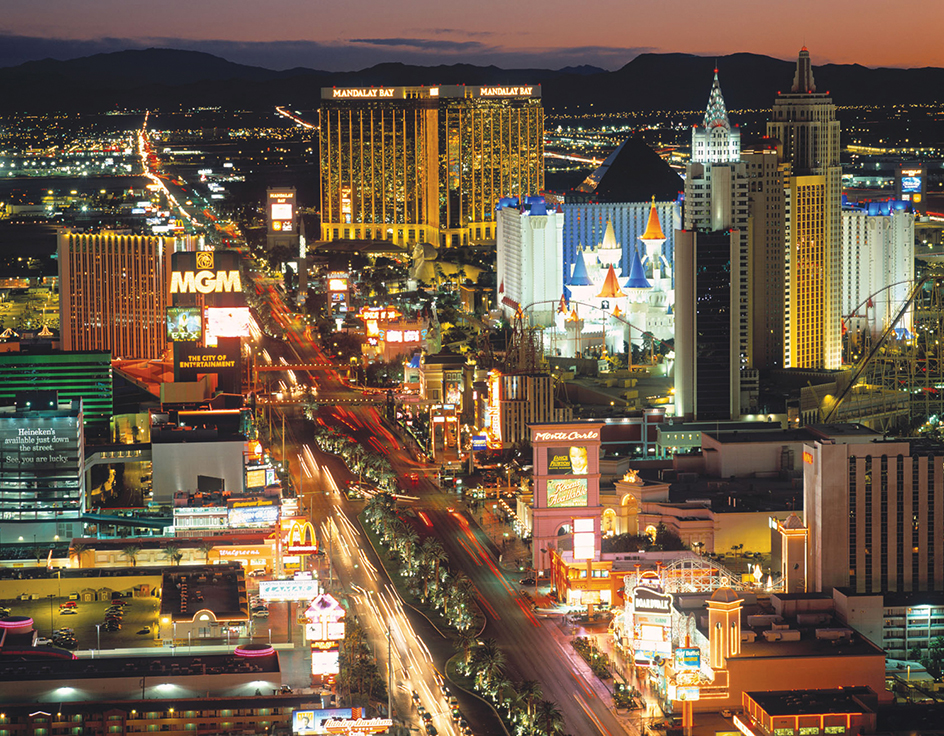
Hotels, restaurants, and retail trade establishments operate primarily in the Las Vegas area. Many of the hotels are casino hotels. Nevada’s main financial centers are Las Vegas and Reno. Real estate has become important as more people move to the state. Since 1980, Nevada has grown faster than any other state.
Government services are also important to Nevada’s economy. Carson City, the state capital, is the center of state government activities. The federal government plays a major role in Nevada’s economy because it owns most of the state’s land. Two federal government facilities, the Nevada National Security Site and Nellis Air Force Base, employ thousands of people. The Nevada National Security Site’s main function is to conduct experiments in order to maintain the safety of the country’s nuclear stockpile.
Mining.
Nevada ranks as one of the leading states in mining income. Gold is Nevada’s most valuable mined product, accounting for over half of the state’s total mining income. Nevada is by far the leading gold-producing state. The largest gold mines are in Elko, Eureka, Humboldt, Lander, and Nye counties. Several other Nevada counties produce significant amounts of gold. Nevada is also a leading producer of silver in the United States. The northern part of the state is the leading silver-producing region. 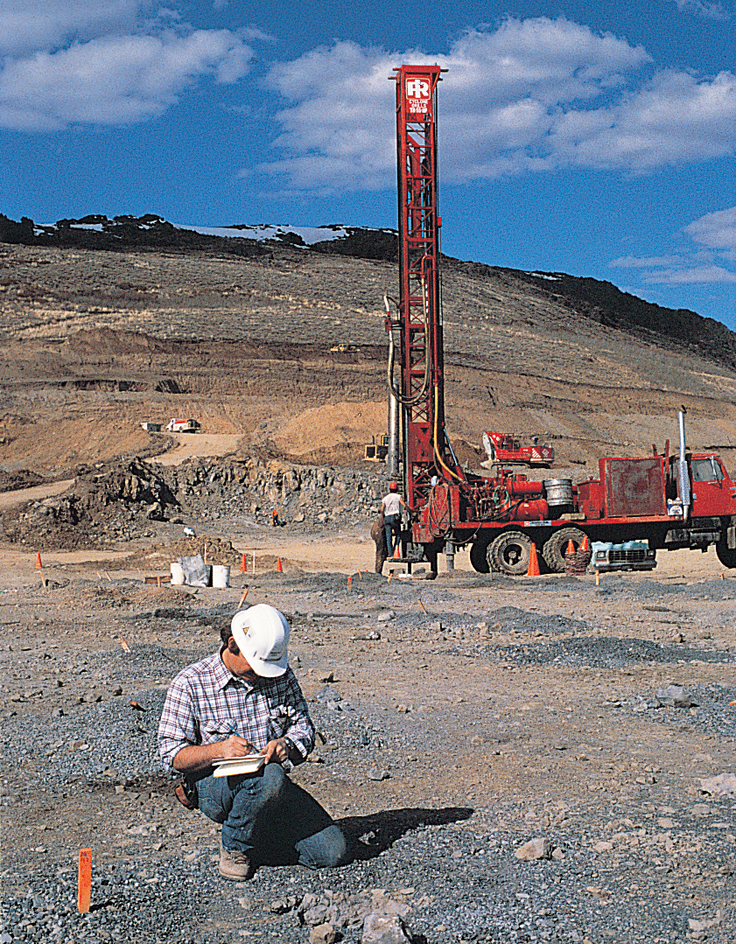
Nevada is a leading state in the production of diatomite, a chalky substance used to make filters. Most of the diatomite is obtained from areas that were once lakes in western Nevada. Nevada is also a leading producer of barite, copper, and gypsum, and the only state to produce lithium carbonate and magnesite.
Manufacturing.
Manufacturing plays less of a role in Nevada’s economy than it does in the economies of most other states. The Carson City, Las Vegas, and Reno areas are the chief manufacturing centers in the state.
Leading manufactured products include computer and electronic equipment, concrete, fabricated metal products, food products, and plastic products. Communication equipment, computers, and semiconductors are primarily produced in the Las Vegas and Reno areas. Concrete is mainly manufactured in the Las Vegas area. Machine shop products, sheet metal products, and structural metal products are the leading fabricated metal products. Baked goods and dairy products are mainly produced in the Las Vegas area. Minden processes coffee beans. Plastic products are primarily manufactured in the Las Vegas and Reno areas. The Las Vegas area also produces neon signs, and the Reno area also produces slot machines and other gaming equipment.
Agriculture.
Livestock ranching accounts for about three-fourths of the state’s agricultural activity. Most of Nevada’s large cattle and sheep ranches are in the northern half of the state. Many ranchers graze their animals for part of the year on public lands that they rent from the federal government. Much of the milk production comes from Churchill, Lyon, and Nye counties.
Irrigated farms operate chiefly near the river valleys of northern and western Nevada. However, irrigated farming projects have been developed throughout the state. Hay is Nevada’s most valuable field crop. The state’s northwestern basins are the leading region for growing hay. Farmers also raise alfalfa seed, barley, corn, garlic, mint, onions, potatoes, and wheat.
Electric power and utilities.
Natural gas burning plants and solar power plants provide most of Nevada’s electric power. Hydroelectric plants at the Davis, Hoover, and Parker dams on the Colorado River provide much of the power for the southern portion of the state. Nevada is a leading producer of geothermal power. Geothermal power is mainly produced in the northern portion of the state. 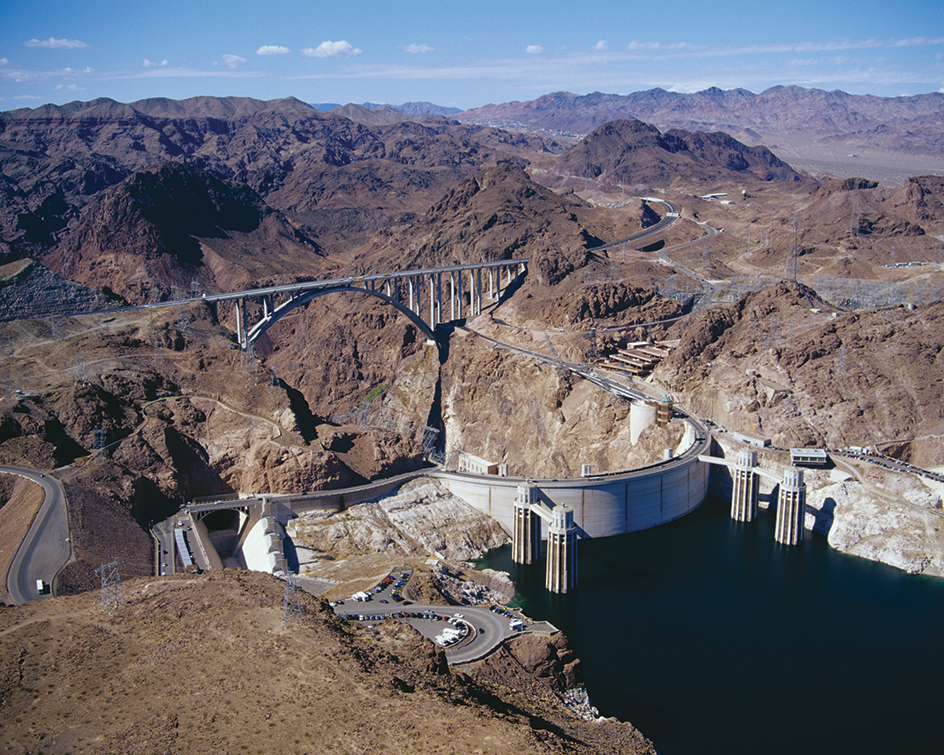
Transportation.
Harry Reid International Airport, in Las Vegas, is one of the nation’s busiest airports. Reno-Tahoe International Airport serves the Reno area. Rail lines provide freight service in the state, and passenger trains serve several Nevada cities.
Communication.
Nevada’s first printed newspaper, the Territorial Enterprise, was established at Genoa in 1858. The American author Mark Twain worked as a reporter on this daily paper from 1862 to 1864, after it was moved to Virginia City (see Twain, Mark (Newspaper work in the West)). Today, daily newspapers with the largest circulations include the Las Vegas Review-Journal and the Reno Gazette-Journal.
Government
Constitution
of Nevada was adopted in 1864, the year the state entered the Union. Nevada’s Constitution may be amended (changed) only by a majority of the voters. An amendment proposed by the Legislature must be approved by a majority of both houses in two successive regular sessions. Then the voters must approve it in the next general election.
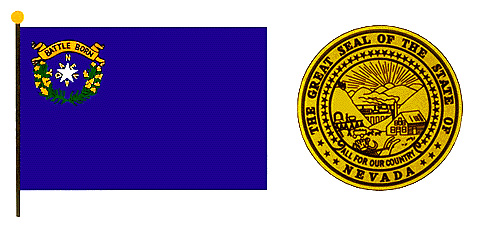
The people may amend the Constitution directly by using the initiative. In this procedure, voters who support the amendment first sign a petition. The number of signatures must equal at least 10 percent of the voters in the last general election in each of Nevada’s congressional districts. The petition states the proposed amendment and calls for a general election to vote on it. If the amendment is approved by a majority of the voters in two successive general elections, it becomes part of the Constitution.
The Nevada Constitution may also be revised by a constitutional convention. To call such a convention, two-thirds of each legislative house must vote for it. Then a majority of voters must approve the convention in the next general election.
Executive.
The governor of Nevada is elected to a four-year term. The governor may serve no more than two elected terms.
Key state officials also are elected to four-year terms. Elected officials include the lieutenant governor, secretary of state, treasurer, controller, and attorney general. These officials may serve no more than two terms. The governor appoints the members of many bureaus, commissions, and administrative boards.
Legislature
consists of a 21-member Senate and a 42-member Assembly. Nevada has 21 senatorial districts and 42 Assembly districts. Each senatorial district elects one senator. Each Assembly district elects one member to the Assembly. Members of the Senate serve four-year terms and may serve no more than three terms. Members of the Assembly serve two-year terms and may serve no more than six terms. 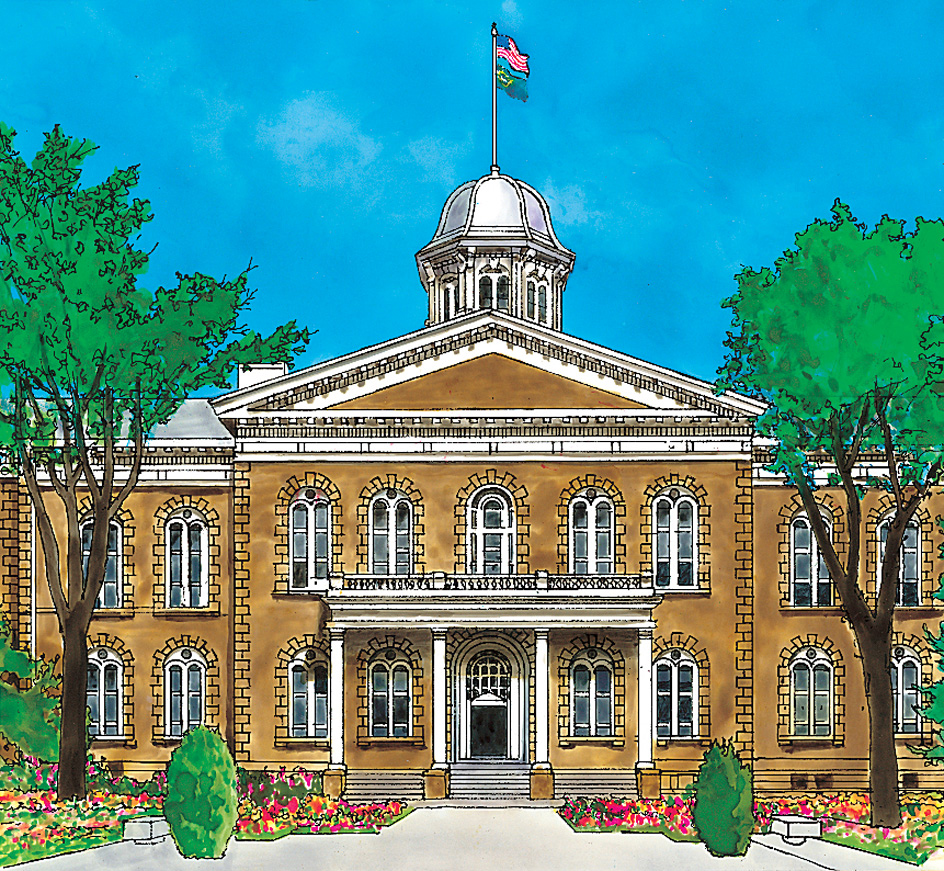
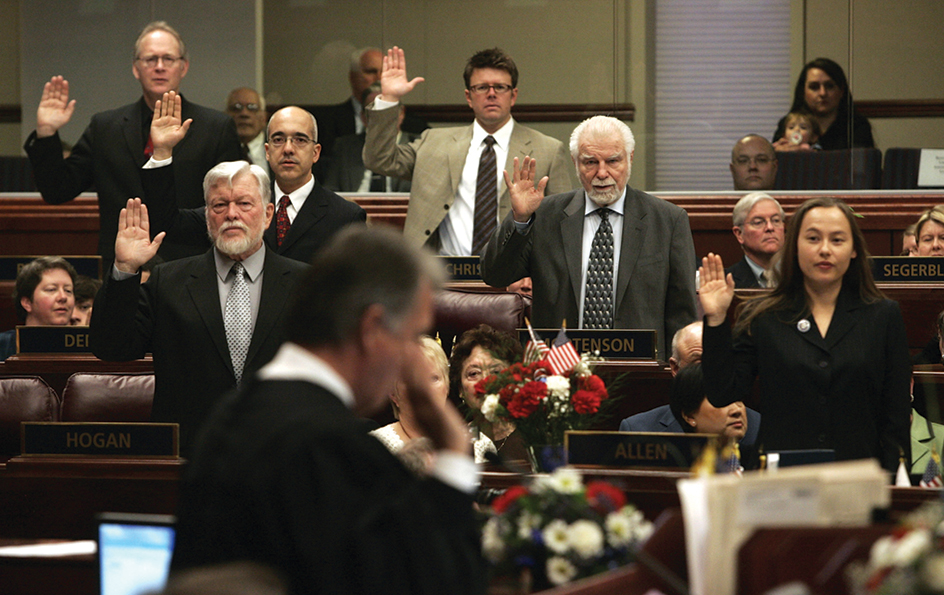
The Legislature meets on the first Monday of February in odd-numbered years. Legislative sessions are limited to 120 days. The governor can call special sessions.
Courts.
The Supreme Court of Nevada has a chief justice and six associate justices, all of whom are elected to six-year terms. Two or three justices are elected every two years. A justice in the final two years of his or her term normally serves as chief justice. Nevada has 11 judicial districts, with more than 80 district judges who serve six-year terms. Court districts with large populations have divisions called departments. Each department is headed by a district judge. Municipal judges serve in Nevada’s city courts, and justices of the peace serve in the state’s townships.
Local government.
Nevada has 17 counties. Sixteen of the counties are governed by boards of county commissioners that have three to seven members. A five-member board of supervisors governs Carson City, which is both a city and a county. County commissioners serve four-year terms. Other elected county officials include the assessor, auditor and recorder, clerk, district attorney, public administrator, and sheriff. The state’s local government officials may serve for no more than 12 years. Most of Nevada’s cities have a mayor-council form of government.
Revenue.
Taxes account for about three-fifths of Nevada’s general revenue (income). Most of the rest comes from federal grants and other U.S. government programs. A sales tax is the most important source of revenue. Taxes on gambling are also important to the state. Nevada allows many forms of gambling that are not legal in most other states. Other important sources of state revenue include taxes on alcoholic beverages, insurance, mining, motor fuel, and tobacco; and license fees for automobiles and the transportation of passengers and freight. State and local governments share revenue from a property tax. Nevada has no personal or corporate income taxes.
To attract industry, Nevada enacted a “free port” tax law in 1949. This law applies to goods being held in Nevada for shipment outside the state. It allows manufacturers to process and store such goods in Nevada without paying property taxes on them. In most states, manufacturers must pay taxes on such goods. The free port law became part of the state Constitution in 1960.
Politics.
The Republican Party is strong in much of Nevada. The Democratic Party’s strength lies mainly in Clark County, where two-thirds of the state’s voters live.
Both Republican and Democratic candidates have had success in elections for governor since the mid-1900’s. In presidential elections, the voters have supported candidates from both parties, though Democrats have gained strength since the early 2000’s.
History
Early days.
Some of the earliest Native Americans lived in the Nevada region. Bones, ashes, and other remains discovered near Las Vegas indicate that Native Americans lived there thousands of years ago. Cave-dwelling people left picture writings on rocks in southern Nevada. Basket Makers once lived at Lovelock Cave, and Pueblo people lived around Las Vegas. Explorers of the early 1800’s found Mohave, Paiute, Shoshone, and Washoe groups in parts of the region. 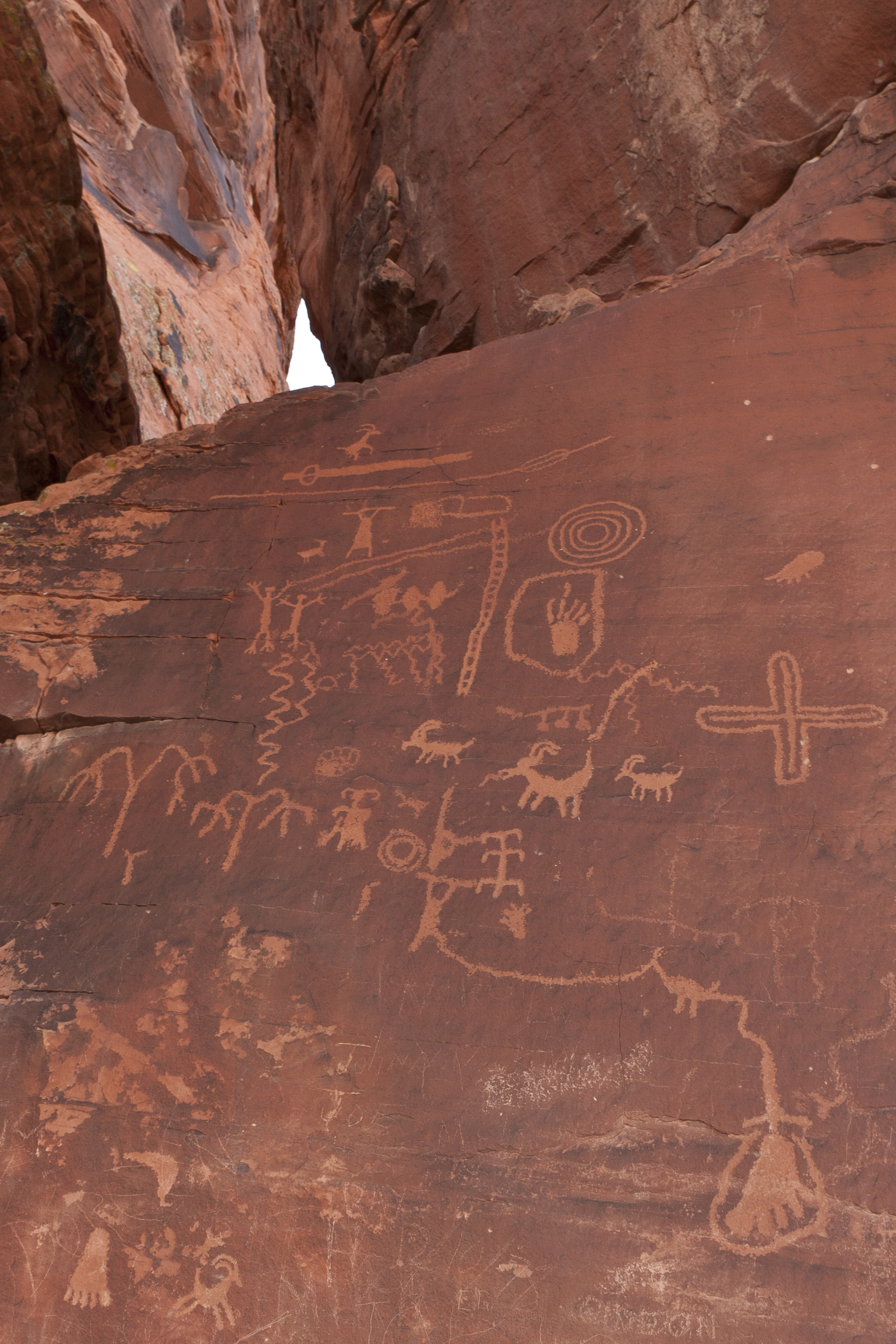
Exploration.
Francisco Garces, a Spanish missionary, possibly was the first white man to enter the Nevada region. He may have traveled through southern Nevada while journeying from New Mexico to California in 1776. Fur traders and trappers began to explore the region between 1825 and 1830. Peter S. Ogden explored the Humboldt River valley with a group of trappers of the Hudson’s Bay Company (see Hudson’s Bay Company). Jedediah S. Smith led some trappers across the Las Vegas valley region into California and then back across the Great Basin.
In 1830 and 1831, William Wolfskill blazed a route, called the Old Spanish Trail, from Santa Fe to Los Angeles. This trail opened Nevada to trade from the southeast. Trapper Joseph Walker blazed a trail along the Humboldt River on his way to California in 1833. Hundreds of wagons rolled westward over this same trail after gold was discovered in California in 1848. Between 1843 and 1845, Lieutenant John C. Frémont explored the Great Basin and Sierra Nevada. Frémont provided the first accurate knowledge of the Nevada region (see Frémont, John Charles).
Early settlement.
At the end of the Mexican War in 1848, the United States acquired the Nevada region from Mexico. Nevada was then part of a territory that also included California, Utah, and parts of four other states (see Mexican War (The peace treaty)).
In 1849, the Mormon leader Brigham Young organized Utah, most of present-day Nevada, and parts of other present-day states as the State of Deseret. He asked Congress to admit his state to the Union. However, in 1850, Congress established the Utah Territory, which included Utah and most of present-day Nevada. President Millard Fillmore appointed Young governor of the territory.
In 1851, Mormons from the Great Salt Lake area in Utah built a trading post at Mormon Station (now Genoa) in the Carson Valley. The post supplied provisions for gold seekers heading for California. During the next few years, a few Mormon families came to farm and raise livestock in the Carson Valley and the surrounding region. This section of Utah Territory was organized into Carson County.
Many non-Mormons in Carson County did not want to be governed by Brigham Young. They pleaded unsuccessfully with Congress to make Carson County part of California. The Mormons themselves were troubled by a dispute with the federal government. In 1857, Young recalled the Mormon settlers to Great Salt Lake because he feared that federal troops would attack them. Two years later, the non-Mormons set up a provisional government in an attempt to establish Carson County as a separate territory. But Congress did not authorize the provisional government because only a few hundred persons lived in the Carson County area.
The Comstock Lode,
a rich deposit of silver ore, was discovered in 1859 at the present site of Virginia City. Henry Comstock, a prospector, took credit for the discovery, though other miners actually had found the ore. News of the Comstock Lode quickly spread to fortune hunters in California and the Eastern United States. Hundreds of prospectors rushed to Carson County to “strike it rich,” settling in tents, rough stone huts, and hillside caves. Almost overnight, Virginia City became a thriving mining center. 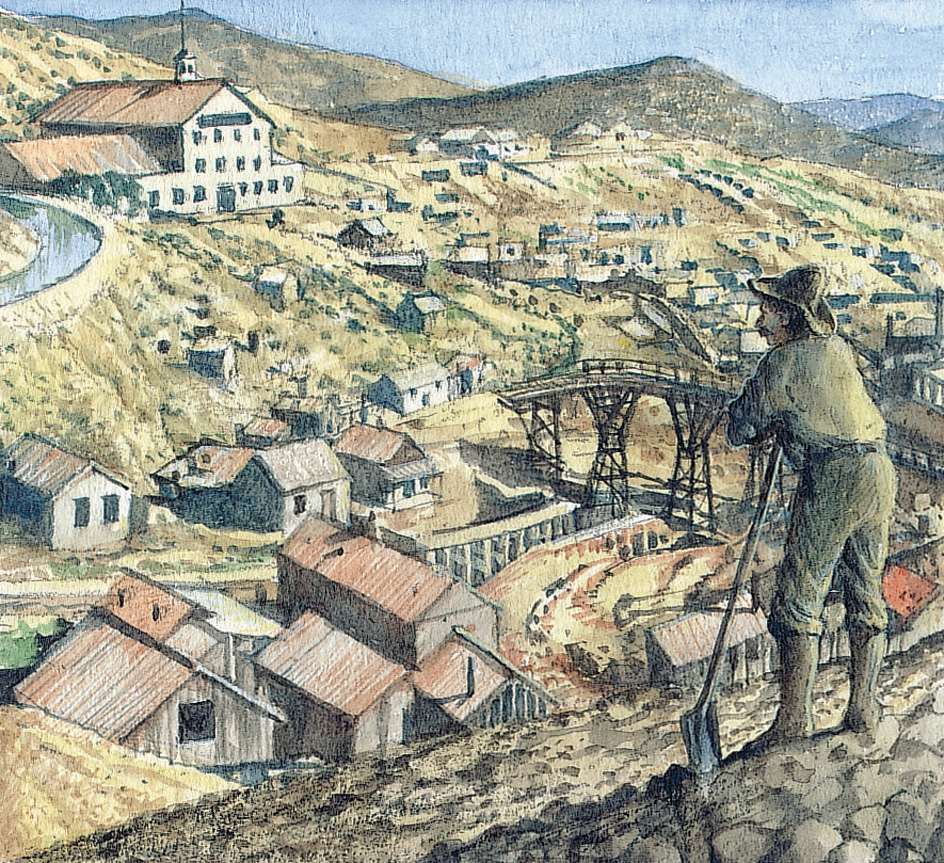
The settlers of the area led a difficult and dangerous life. They paid unbelievably high prices for provisions that had to be hauled from California over the Sierra Nevada. Some miners became millionaires. However, many other miners found little or no wealth. Many mining camps were lawless, and many miners were rowdies or gunmen. See Comstock Lode.
Nevada becomes a territory.
By 1860, the booming mining camps of Carson County held more than 6,700 people. In March 1861, President James Buchanan signed an act creating the Nevada Territory. President Abraham Lincoln, who took office two days later, appointed James W. Nye, a New York City politician, governor of the territory.
The Civil War (1861-1865) began before Nevada’s territorial government could be set up in Carson City. Most Nevadans favored the North. Lincoln needed another “northern” state to support his proposed antislavery amendments. He knew that most Nevadans favored his Administration and would be likely to elect Republican senators who would support his policies. At the time, the Nevada Territory had far less than the 127,381 residents required by law to become a state. But Nevadans held a convention anyway and drew up a state constitution.
Statehood.
The convention met in November 1863, but ended in failure. The voters rejected the proposed constitution because of its provisions for the taxing of mines. Congress then passed an act authorizing a second Nevada convention. In July 1864, this convention met and completed its work. In September, the revised constitution won the approval of the voters. The people elected Republican Henry G. Blasdel, a mining engineer, their first governor. President Lincoln proclaimed Nevada a state on Oct. 31, 1864. 
Mine failure and recovery.
In the 1870’s, mining companies dug the richest silver ore from Nevada’s mines. Some of the state’s mines produced only “low-grade” ores that contained small amounts of silver. Mine owners made a profit on these ores because silver had a high value.
During the early 1870’s, the U.S. government limited the use of silver in its money system. As the government’s demand for silver fell, the value of silver also dropped. As a result, many mines closed because they could no longer produce low-grade ores at a profit, and many people lost their jobs. Unemployed people began to leave Nevada by the thousands to find work elsewhere. The state’s population dropped from 62,266 in 1880 to 47,355 in 1890. Many thriving communities became ghost towns.
As mining failed, ranching grew in importance. But the ranchers also faced difficult problems. They had to pay the railroad extremely high rates to ship their stock. In addition, severe winters in the late 1880’s killed thousands of cattle. Many owners of small herds became bankrupt and had to sell out to operators of large ranches.
Economic recovery began with new mineral discoveries in 1900. Prospectors found huge deposits of silver at Tonopah. They could be mined profitably, although silver still had a low value. Prospectors uncovered copper ores at Ruth and Kimberly, near Ely. In 1902, gold was discovered at Goldfield. Rich deposits discovered the next year brought thousands of miners back to Nevada.
As the mining industry came to life again, the railroads built branch lines to the mining areas. Trains brought equipment to the mines and hauled ore away to processing plants. Cattle owners also used the new branch lines for speedy beef shipments.
Nevada’s Newlands Irrigation Project, the country’s first federal irrigation project, was completed in 1907. In this project, dams along the Carson and Truckee rivers create irrigation reservoirs and generate electric power. Water from this system supplies an agricultural region that developed near Fallon in the west-central part of Nevada.
The richest of Nevada’s gold and silver deposits were running out when the United States entered World War I in 1917. Industries then began to demand copper, tungsten, zinc, and other metals for weapons and wartime supplies. Many new mines opened in Nevada, and mine owners collected top prices for the metals. But prices fell after the war ended in 1918, and many mines closed.
In 1928, Congress authorized the construction of Hoover Dam on the Colorado River. Work on the dam began in 1930. The huge project was completed in 1935. Hoover Dam provides power and stores up irrigation water for parts of Nevada, Arizona, and California.
Legal gambling and easy divorce.
As early as 1869, Nevada’s Legislature had permitted gamblers to operate games of chance in the state. By 1910, various groups of citizens had succeeded in having laws passed against gambling. But Nevada’s individualist culture and the limits of law enforcement made the laws largely ineffective. In 1931, Nevada made gambling legal. Numerous gambling casinos began to operate in the state during the 1930’s.
In the early 1900’s, Nevada had passed laws that made it easy to get a divorce. A person had to live in Nevada for only six months to get a divorce there. In 1927, the Nevada Legislature passed a law allowing persons to obtain a divorce if they lived in the state for only three months. In 1931, the period was reduced to six weeks. During the mid-1900’s, thousands of people went to Nevada each year to get divorces quickly and easily.
The mid-1900’s.
World War II (1939-1945) created new business for Nevada’s mining industry. Manufacturers of military supplies purchased large amounts of the state’s copper, lead, magnesite, manganese, tungsten, and zinc. After the war, mining decreased. The industry gradually switched to the production of gypsum, lime, and other nonmetallic minerals.
In the late 1940’s, Nevada began a widespread campaign to attract new industry. Although the campaign brought a number of factories into the state, Nevada’s economy during the 1950’s and 1960’s depended chiefly on nuclear research and tourism.
In 1950, the Atomic Energy Commission (AEC) set up a testing center about 60 miles (97 kilometers) northwest of Las Vegas. The next year, the AEC began testing nuclear weapons. Between 1951 and 1963, 127 aboveground atomic and nuclear tests took place in Nevada. Underground testing continued for 30 more years. In 1992, the federal government halted all nuclear weapons testing. 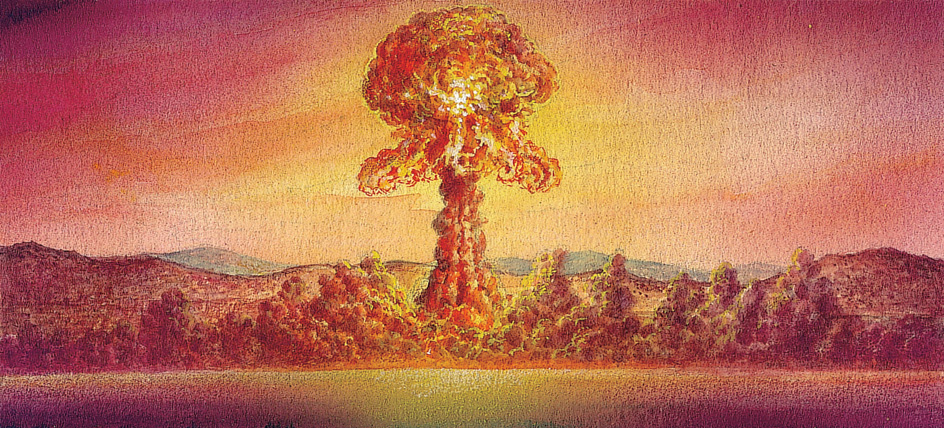
Tourism remained Nevada’s largest and fastest-growing industry during the 1950’s and 1960’s. By the late 1960’s, the Las Vegas area alone attracted annually about 15 million tourists, who spent about $400 million. Tourists also flocked to the state’s two other main resort centers, Reno and the Lake Tahoe area.
In the late 1950’s, the Nevada Legislature set up strict gambling regulations to prevent cheating and to stop criminals from entering or influencing the gambling industry. The regulations require every gambling house to have a state license, which is issued only after investigation by the Gaming Control Board and final approval by the Gaming Commission. In 1967, the Legislature passed a law allowing corporations that sell stock to the public to hold gambling licenses. The new law was a further attempt to keep the underworld out of the gambling industry.
In 1963, the Supreme Court of the United States settled a 40-year dispute between Arizona, California, and Nevada over water supplies from the Colorado River. The court ruled on how much water each state could draw from the river every year.
In 1966, Howard Hughes, an American businessman and one of the world’s richest people, moved to Las Vegas. He then bought airports, casinos and hotels, large tracts of land, and a television station in the area.
In 1967, the Water Project (now called the Robert B. Griffith Water Project) was created to provide increased water supplies for the expected growth in the Las Vegas area. The final stage of the project, which brings water from Lake Mead, was completed in 1983.
The late 1900’s.
In the late 1970’s, Las Vegas and Reno began projects to improve their airport facilities to accommodate a continuing increase in the number of tourists. Reno’s project was completed in 1981. Expansion of the McCarran International Airport (now Harry Reid International Airport) in Las Vegas was completed in 1998.
Air and water pollution became serious problems in Nevada in the late 1900’s. In one program to control water pollution, Nevada joined with California in the Tahoe Regional Planning Compact in 1980 to fight pollution of Lake Tahoe. By the 1990’s, the compact had resulted in environmental improvements in the area.
The early 2000’s.
Today, tourism remains Nevada’s largest industry. The state’s manufacturing and construction industries grew rapidly during the 1990’s and first part of the 2000’s. The increase in tourism and the relocation of manufacturing facilities to the Las Vegas and Reno metropolitan areas contributed to the growth of those areas. Growth also helped make the state’s population more ethnically and racially diverse. But Nevada cities faced major problems as their populations increased. City dwellers demanded better police and fire protection, improvements in education, better recreational facilities, and other services. 
In 2002, President George W. Bush approved controversial legislation to bury nuclear waste in Nevada. The waste would have been buried at Yucca Mountain, on the federal lands in Nye County that include Nellis Air Force Base and the Nevada Test Site. Nevada officials and environmentalists opposed the legislation and filed several lawsuits to block it. In 2009, Secretary of Energy Steven Chu said that the administration of President Barack Obama no longer considered Yucca Mountain an option for storing nuclear waste.
Nevada’s economy suffered greatly during a national economic downturn that began in 2008. The state’s construction and manufacturing industries struggled, and Nevada consistently had one of the nation’s highest unemployment rates. The state’s employment situation showed marked improvement during the 2010’s, however.
In October 2017, a gunman opened fire on a crowd attending a country music concert in Las Vegas. At least 58 people were killed in the incident, and several hundred others were injured.
The COVID-19 pandemic caused great economic and social disruptions beginning in 2020. To slow the spread of the sometimes-fatal respiratory disease, authorities canceled public events and ordered the temporary closure of many businesses. Despite such efforts, many Nevadans became infected, and many died. Vaccines became available to most Nevadans in 2021. Infection and death rates fell dramatically, and the state’s tourism-based economy improved. Nevertheless, by early 2023, there had been about 900,000 confirmed cases of COVID-19 in Nevada, and about 12,000 confirmed deaths from the disease.
